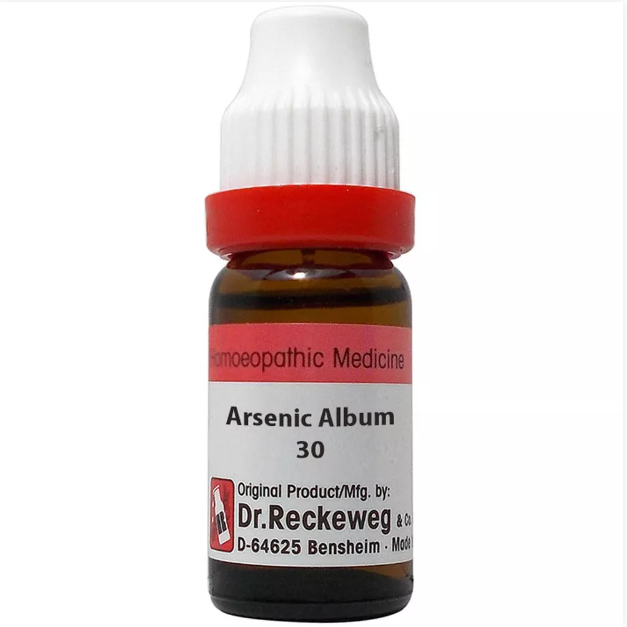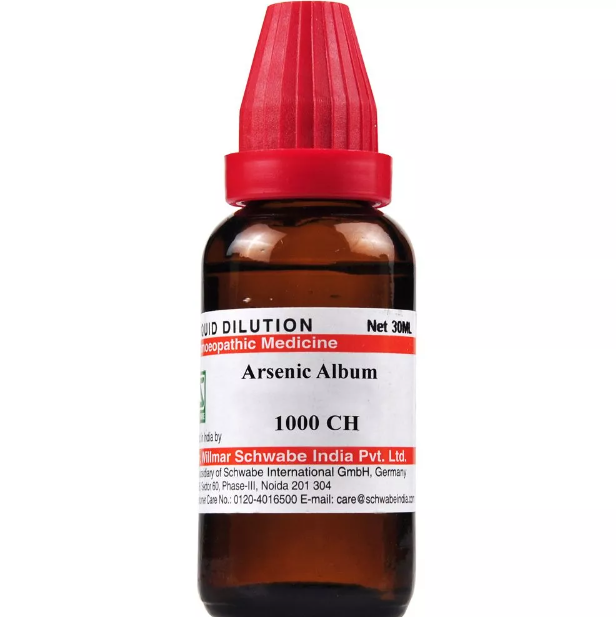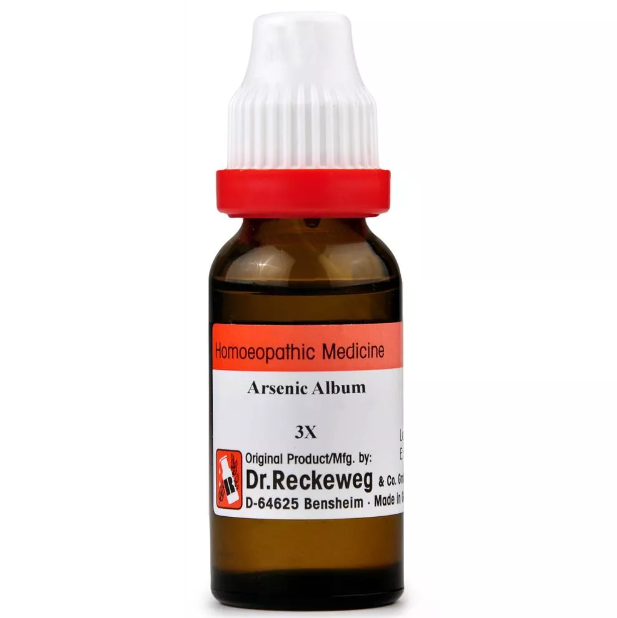ARSENICUM ALBUM 3x, 6C, 12C, 30C, 200C, 1M, 10M USES AND SYMPTOMS
 ARSENICUM ALBUM
ARSENICUM ALBUM
(Arsenious Acid, Arsenic Trioxide)
Ars.
Works deeply on every part of the body. Its distinct symptoms and relevance to various severe illnesses ensure its consistent and effective use in homeopathy. Its general symptoms, notably pervasive fatigue, weakness, and restlessness worsening at night, are key indicators. Profound exhaustion even from minimal effort characterizes it, alongside heightened irritability. Burning pains and unquenchable thirst are prominent. Provides relief from burning sensations with warmth. Useful for coastal ailments (like Nat-m., Aqua marina). Calms and eases the final moments of life when administered in high potency. Anxiety, fear, and green discharges. Particularly helpful in conditions arising from alcoholism, food poisoning, insect bites, and exposure to decayed matter. Discharges emit a putrid odor. Symptoms recur yearly. Useful for anemia, chlorosis, and degenerative changes. Aids in maintaining vitality during cancerous conditions and septic infections.
Mind: Intense restlessness and distress. Constantly moves about. Fear of death and being alone. Overwhelming fear accompanied by cold sweats. Belief in the futility of treatment. Suicidal tendencies. Hallucinations involving smell and sight. Driven by despair to wander. Displays traits of miserliness, malice, and selfishness; lacks bravery. Heightened sensitivity to disorder and chaos.
Head: Headaches alleviated by cold, worsened by other cold symptoms. Periodic burning pains and restlessness, with cold skin. Migraines with scalp feeling icy and extreme weakness. Scalp itching, especially at night, with dry scales and hair loss. Scalp sensitive, cannot tolerate hair brushing.
Eyes: Burning sensation with watery discharge. Red, ulcerated, and scabby eyelids. Swelling around the eyes. Extreme pain with external inflammation; burning and excoriating tears. Corneal ulcers. Severe sensitivity to light, relieved by warmth. Fine burning pain in ciliary neuralgia.
Ears: Raw and burning sensation inside. Thin, offensive discharge. Roaring in ears during painful episodes.
Nose: Watery, excoriating discharge. Feeling of nasal congestion. Frequent sneezing without relief. Aggravated hay fever and colds outdoors; relieved indoors. Nosebleeds and burning sensations. Acne and lupus of the nose.
Face: Swollen, pale, yellow, sunken, cold, and sweaty face. Expression of agony. Sharp, burning pains. Lips black and livid. Flushes of anger on the cheeks.
Mouth: Easily bleeding gums. Mouth ulcers with dryness and burning heat. Tongue dry, red, and ulcerated; burning and stitching pains. Saliva tinged with blood. Toothaches with extreme soreness; worsened at night and relieved by warmth. Metallic taste. Regurgitation of burning fluid.
Throat: Swollen, constricted, burning throat; difficulty swallowing. Dry, wrinkled appearance of diphtheritic membrane.
Stomach: Aversion to food smells. Intense thirst; drinks in small sips. Nausea and vomiting after eating or drinking. Anxiety in the stomach. Craving for acids and coffee. Heartburn with acidic eructations. Vomiting of blood, bile, or green mucus. Gastric sensitivity, as if raw (gastric ulcer). Painful digestion, worsened by various foods and drinks. Fear, dyspnea, and faintness with stomach pain. Sensation of food sticking in the esophagus. Negative effects of a vegetable diet and watery fruits. Craves milk.
Abdomen: Burning pains relieved by warmth. Enlarged and painful liver and spleen. Ascites and abdominal swelling. Pain like a wound on coughing.
Rectum: Painful protrusion of rectum. Tenesmus and burning pain in rectum and anus. Hemorrhoids burn intensely; relieved by warmth. Skin around anus excoriated.
Stool: Small, foul-smelling, dark stools; with marked weakness. Worse at night, after eating or drinking, and from cold. Dysentery with dark, offensive stools. Cholera with intense agony and thirst. Body cold as ice.
Urinary: Scanty, burning, involuntary urine. Bladder feels paralyzed. Presence of albumin. After urination, weakness in the abdomen. Associated with Bright’s disease and diabetes.
Female: Excessive and early menstruation. Burning pain in ovarian region. Leucorrhea acrid, burning, and offensive. Menstrual pain as if from hot wires; worsened by exertion and relieved by warmth. Menorrhagia and pelvic pain extending to thighs. Endometritis.
Respiratory: Cannot lie down due to fear of suffocation. Constricted air passages. Midnight asthma attacks. Chest burning and suffocative catarrh. Cough worse at midnight, especially lying on the back. Scanty, frothy expectoration. Painful cough with pneumonia. Wheezing breaths. Hemoptysis with back pain; general heat sensation. Dry cough, as if from sulfur fumes; worsened after drinking. Pleurisy.
Heart: Palpitations, pain, dyspnea, faintness. Irritable heart in smokers and tobacco users. Faster pulse in the morning. Dilatation and cyanosis. Angina pectoris with neck and occipital pain.
Back: Weakness in the lower back. Shrugged shoulders. Pain and burning in the back.
Extremities: Tremors, spasms, weakness, heaviness, and unease. Calf cramps. Swelling in feet. Sciatica and burning pains. Peripheral nerve inflammation and diabetic gangrene. Heel ulcers and lower limb paralysis with wasting.
Sleep: Anxious and restless sleep. Head elevated during sleep. Suffocative episodes during sleep. Hands placed over the head while sleeping. Dreams filled with worry and fear. Drowsiness and sleeping sickness.
Fever: High body temperature with marked periodicity. Seen in septic and intermittent fevers. Paroxysms accompanied by extreme exhaustion. Cold sweats. Typhoid fever with exhaustion. Delirium worsened at midnight. Profound restlessness. Intense heat around 3 a.m. Presence of dark crusts.
Skin: Itching, burning, swelling, and edema. Papular, dry, rough, and scaly eruptions. Worsened by cold and scratching. Malignant pustules and offensive ulcers. Anthrax and poisoned wounds. Urticaria with restlessness and burning. Psoriasis and skin cancer. Coldness of the body. Epithelioma of the skin and gangrenous inflammations.
Modalities: Aggravated by wet weather, after midnight, cold, cold food or drinks, coastal conditions, and right side. Relieved by warmth, elevated head, and warm drinks.
Relationship: Complementary to Rhus-t., Carb-v., Phos., Thuj., Sec.
Antidotes to lead poisoning. Antidotes: Op., Carb-v., Chin., Hep., Nux-v.
Chemical antidotes: Charcoal; Hydrated peroxide of iron; Lime water.
Compare with Arsenicum stibiatum 3x, Cenchris contortrix, Iod., Phos., Chin., Verat., Carb-v., Kali-p.
Dose: Third to thirtieth potency. The very highest potencies often yield brilliant results.
Low attenuations in gastric, intestinal, and kidney diseases; higher in neuralgias, nervous diseases, and skin. But if only surface conditions call for it, give the lowest potencies, 2x to 3x trituration. Repeated doses advisable.
SYMPTOMS OF ARSENICUM ALBUM
General Symptoms:
- Fatigue, weakness, restlessness worsening at night
- Profound exhaustion even from minimal effort
- Heightened irritability
- Burning pains
- Unquenchable thirst
- Relief from burning sensations with warmth
Mind:
- Intense restlessness and distress
- Fear of death and being alone
- Overwhelming fear with cold sweats
- Belief in futility of treatment
- Suicidal tendencies
- Hallucinations involving smell and sight
- Driven by despair to wander
- Displays traits of miserliness, malice, selfishness; lacks bravery
- Heightened sensitivity to disorder and chaos
Head:
- Headaches alleviated by cold, worsened by other cold symptoms
- Periodic burning pains and restlessness
- Migraines with scalp feeling icy and extreme weakness
- Scalp itching, especially at night, with dry scales and hair loss
- Scalp sensitive, cannot tolerate hair brushing
Eyes:
- Burning sensation with watery discharge
- Red, ulcerated, and scabby eyelids
- Swelling around the eyes
- Extreme pain with external inflammation; burning and excoriating tears
- Corneal ulcers
- Severe sensitivity to light, relieved by warmth
- Fine burning pain in ciliary neuralgia
Ears:
- Raw and burning sensation inside
- Thin, offensive discharge
- Roaring in ears during painful episodes
Nose:
- Watery, excoriating discharge
- Feeling of nasal congestion
- Frequent sneezing without relief
- Aggravated hay fever and colds outdoors; relieved indoors
- Nosebleeds and burning sensations
- Acne and lupus of the nose
Face:
- Swollen, pale, yellow, sunken, cold, and sweaty face
- Expression of agony
- Sharp, burning pains
- Lips black and livid
- Flushes of anger on the cheeks
Mouth:
- Easily bleeding gums
- Mouth ulcers with dryness and burning heat
- Tongue dry, red, and ulcerated; burning and stitching pains
- Saliva tinged with blood
- Toothaches with extreme soreness; worsened at night and relieved by warmth
- Metallic taste
- Regurgitation of burning fluid
Throat:
- Swollen, constricted, burning throat; difficulty swallowing
- Dry, wrinkled appearance of diphtheritic membrane
Stomach:
- Aversion to food smells
- Intense thirst; drinks in small sips
- Nausea and vomiting after eating or drinking
- Anxiety in the stomach
- Craving for acids and coffee
- Heartburn with acidic eructations
- Vomiting of blood, bile, or green mucus
- Gastric sensitivity, as if raw (gastric ulcer)
- Painful digestion, worsened by various foods and drinks
- Fear, dyspnea, and faintness with stomach pain
- Sensation of food sticking in the esophagus
- Negative effects of a vegetable diet and watery fruits
- Craves milk

selection of the potency
Individualization:
- Homeopathy is based on the principle of treating the individual, not just the disease. The unique symptoms and characteristics of the person are crucial in determining the most suitable potency.
Intensity of Symptoms:
- The intensity of the symptoms guides the choice of potency. If the symptoms are intense and acute, a lower potency (e.g., 6C, 30C) might be considered. For chronic conditions with less intensity, higher potencies (e.g., 200C, 1M) may be appropriate.
Sensitivity of the Patient:
- Some individuals are more sensitive to homeopathic remedies, while others may require higher potencies. The practitioner considers the patient’s sensitivity when selecting the potency.
Acute vs. Chronic Conditions:
- Lower potencies are often used for acute conditions, while higher potencies may be considered for chronic or long-standing issues.
Previous Response to Potencies:
- The patient’s response to previous homeopathic treatments helps guide the choice of potency. If a particular potency has been effective in the past, it may be repeated or adjusted as needed.
Vital Force and Susceptibility:
- Homeopathy views illness as a disturbance in the vital force. The practitioner assesses the patient’s overall vitality and susceptibility to determine the appropriate potency.
Aggravation or Amelioration:
- The direction of the symptom response (aggravation or amelioration) after taking a remedy can influence the choice of potency.
Miasmatic Considerations:
- In classical homeopathy, the concept of miasms (inherited disease tendencies) is considered. The practitioner take this into account when selecting the potency.
Practitioner Experience:
- The experience and preference of the homeopathic practitioner play a role. Some practitioners may have success with certain potencies based on their clinical experience.
SAFETY INFORMATION
- Do not exceed the recommended dose by physician
- Keep out of the reach of children
- Store in a cool dry place away from direct sunlight
- Maintain half an hour gap between food/drink/any other medicines and homoeopathic medicine
- Avoid any strong smell in the mouth while taking medicine e.g. camphor, garlic, onion, coffee, hing
Medicine images use for reference only selection of homeopathic medicine depends on the individual’s specific symptoms and overall constitution. Moreover, homeopathy is a holistic system of medicine that treats the individual as a whole. In addition to addressing the physical symptoms, it takes into account the emotional and mental state of the person. Consequently, it’s crucial to consult with a qualified homeopathic practitioner for personalized treatment.
The information provided on this website is intended solely for educational purposes. Always seek the advice of your physician or other qualified health provider.
